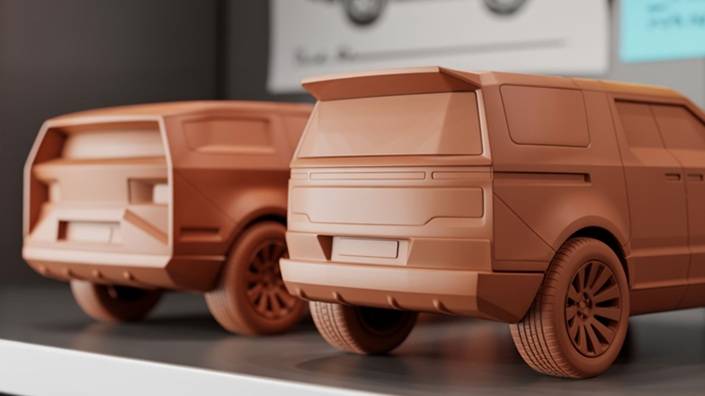Tesla rolled out Master Plan Part 4 with big talk about AI, robotics, and energy. What it didn’t deliver was a clear car roadmap. But buried in a blink‑and‑you‑miss‑it shot was a juicy Easter egg: a shelf of clay models that suggest Tesla sketched out more Cybertruck-shaped vehicles than it’s letting on—an SUV and a minivan/van among them.

During a scene showing a Cybercab front end being sculpted from clay, a shelf of scale models appears for a split second. A Redditor froze the frame and found four vehicles:
- Far left: Covered by plastic, likely the production Cybertruck.
- Far right: A rounded design with its nose obscured—interesting on its own.
- Middle two: The headliners. Both echo the Cybertruck’s origami geometry, but they’re clearly different body styles:
- A taller rear, SUV-like model with a blockier, more upright front fascia
- A minivan/van silhouette—what fans immediately dubbed a possible “Cybervan”
Why these designs matter
- Filling the lineup gaps: Tesla once pledged to hit “every major segment.” An SUV and a van would cover two very real holes—especially a family/cargo hauler that sits between Model Y and the Semi.
- The van pressure is real: Owners have been asking for a Tesla van for years. Meanwhile, rivals are already in the space: Ford E‑Transit, Mercedes eSprinter, Rivian’s commercial vans (and the R2/R3 family coming), and VW’s ID.Buzz (in Europe, U.S. soon).
- A robotaxi tie‑in: Tesla’s own “Robovan” sketch and the Cybercab reveal hint at modular people‑mover ideas. A Cybertruck‑derived van feels like a natural platform for shuttle service—if the strategy were still car‑first.
Tesla has openly said the Cybertruck is a technology testbed—not a long‑term materials template. The company loves what’s inside (48‑volt architecture, steer‑by‑wire, advanced harnessing), but it’s already thrown cold water on bringing the truck’s stainless-steel skin to future consumer models. The new Master Plan also makes the near‑term emphasis clear: AI, robotics, and energy. Cars? Still important—but no longer the headline.
In short: those shelf models look like real design studies, but the odds of them turning into production vehicles anytime soon are slim.
| Concept spotted | What it looks like | Where it might fit | Reality check |
|---|---|---|---|
| Cyber‑SUV | Taller rear, upright face, blocky stance | 3‑row family hauler, trails-capable | Low. Tesla can stretch Model Y/next‑gen platform more cheaply than reinventing a stainless-style SUV. |
| Cyber‑van / “Cybervan” | Minivan/van profile, slab sides | Family shuttle, delivery/ride‑hail van, Robovan | Low‑to‑medium interest, but low near‑term probability. Tesla has teased a van before; execution would require a focused commercial strategy. |
| Rounded mystery model | More curvy, nose hidden | Aero‑optimized shuttle variant? | Unknown—but the rounded nose suggests a break from the truck’s brutalism. |
Why a Cyber‑SUV or Cyber‑van is unlikely right now
- Cost vs. margin: The Cybertruck’s exotic manufacturing and tricky panel work aren’t the recipe for fast, profitable scale. Any new consumer model needs to be simpler and cheaper to build, not more complex.
- Strategy shift: Master Plan Part 4 centers on AI, robotics, and energy. New car programs take people, time, and money—exactly what Tesla says it’s refocusing on software and autonomy.
- Global competition: In Tesla’s biggest battlegrounds—China and Europe—price pressure is intense. A stainless‑style SUV or van is the opposite of a cost-down fighter.
- Platform reuse, not body drama: Tesla has said the Cybertruck’s “guts” (48V electrical, steer‑by‑wire) will migrate into future vehicles. Expect the tech, not the sheet metal.
Even if we never see a Cyber‑van, the truck’s under-the-skin innovations are the important inheritance:
- 48‑volt architecture: Cuts weight and complexity relative to legacy 12V systems.
- Steer‑by‑wire: Enables tighter turning circles, new packaging possibilities, and potentially easier autonomy integration.
- Simplified harnessing and module design: Better for scaling next‑gen vehicles on cost and assembly time.
- Vans are a thing. Electrified vans and shuttles are growing—because cities want quieter streets and businesses want lower total cost of ownership. If Tesla ever reopens the van playbook, it would likely be as a high‑utilization fleet vehicle (robotaxi, shuttle, delivery) before a family minivan.
- SUVs sell—everywhere. A Cyber‑SUV would photograph well, but it competes with Model Y—a profit center built at scale. A bolder SUV makes sense only if it can be produced cheaper or sold at higher margin. Today, neither is obvious.
- If you’re holding out for a “Cybervan,” plan B is smarter. Great electric vans are already here (or arriving): Ford E‑Transit for commercial duty, Mercedes eSprinter for fleets, and VW ID.Buzz for people-moving fun. If you need a family EV now, a three‑row SUV from Kia/Hyundai or an upcoming U.S.‑bound ID.Buzz may serve you better than waiting on a maybe.
- Expect evolution, not revolution. Tesla’s next consumer models are more likely to be cost‑down, high‑volume vehicles (small crossover, compact sedan, a simplified Model Y) rather than wild new body styles.
Tesla’s video Easter egg is a reminder that car design studios sketch far more than ever reaches the road—and that Cybertruck’s angular DNA did spark a family of “what‑ifs.” But Master Plan Part 4 makes the company’s priorities plain: channel Cybertruck’s tech into mainstream platforms, push hard on autonomy and energy, and keep factories focused on what scales.
Could a Tesla van or SUV with Cybertruck attitude appear someday? Never say never. For now, though, those shelf models look like a fun peek behind the curtain rather than a production preview—and the real action for Tesla is happening in code, factories, and battery lines, not in stainless‑steel body panels.
Related Post




